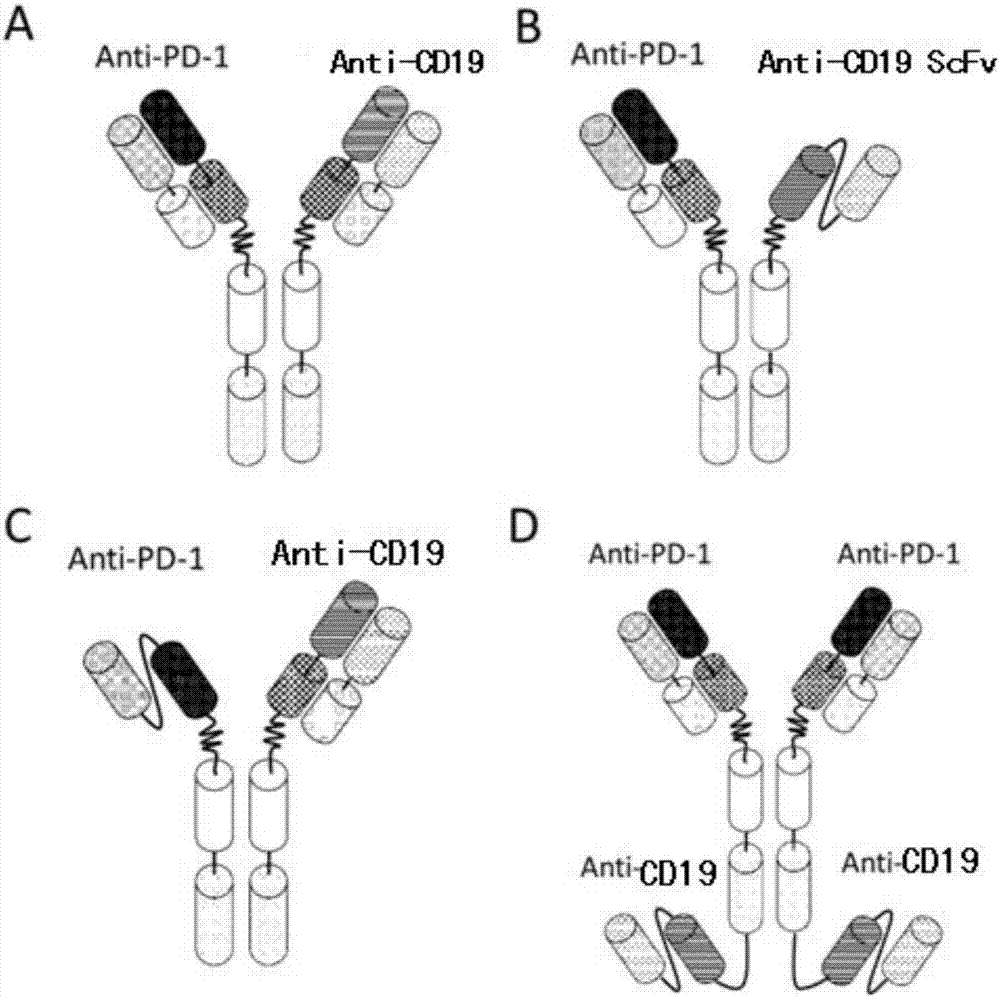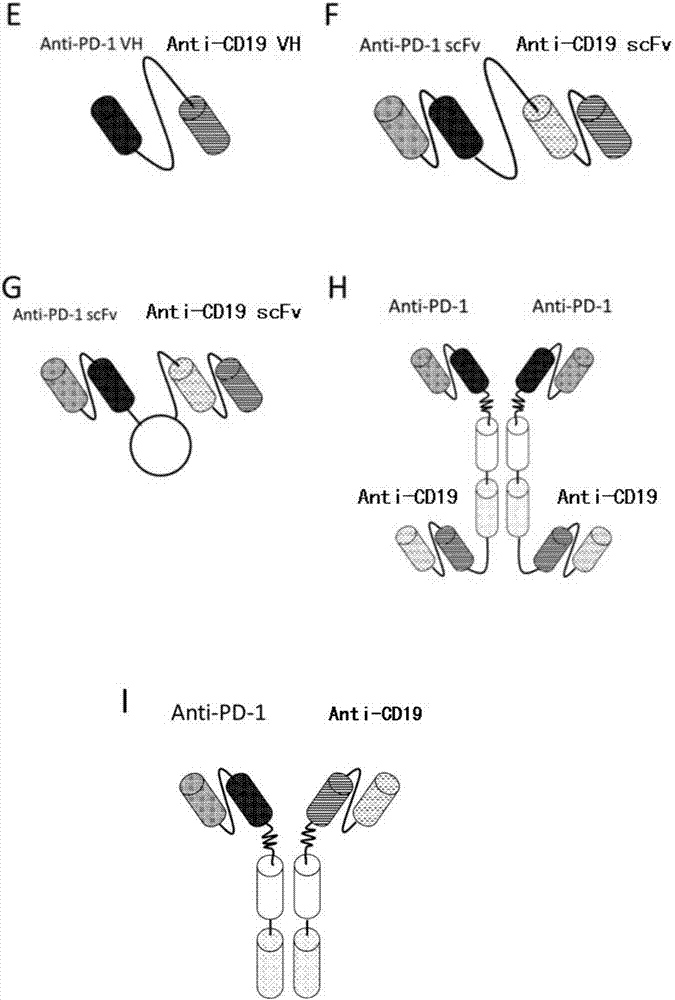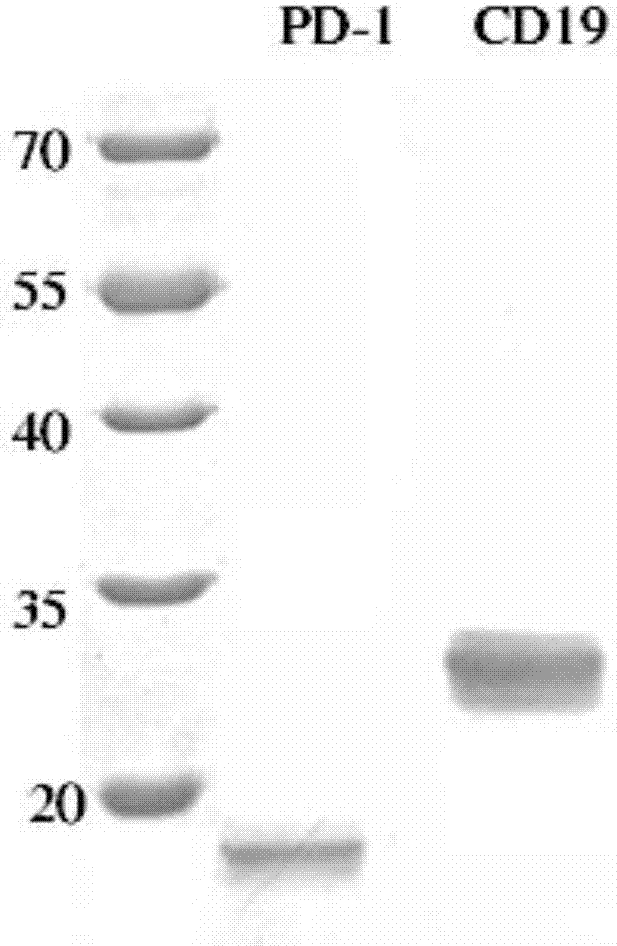Anti-PD1 and anti-CD19 bispecific antibody and applications thereof
A bispecific antibody and specific technology, applied in the field of antibody drug development and production, can solve the problem of weakening the immune effect of tumors
- Summary
- Abstract
- Description
- Claims
- Application Information
AI Technical Summary
Problems solved by technology
Method used
Image
Examples
Embodiment 1
[0072] Example 1 Structural Design of PD-1 / CD19 Bispecific Antibody
[0073] The present invention provides some structural models of bispecific antibodies that can specifically bind to the extracellular domains of PD-1 and CD19 at the same time. The structures of the four main examples of such antibodies are as follows figure 1 as shown, figure 1 The formation of the three heterodimers in (A-C) is based on the CH3 domain mutation technique ("knob and hole mutation") well known to those skilled in the art (VonKreudenstein et al., MAbs.2013 5(5):646- 54). (Among them, (A) light chain (anti-PD-1VL-CL)-heavy chain (anti-PD-1VH-CH1-hinge region-CH2-CH3) of anti-PD-1 specific antibody is paired with anti-CD19 specific antibody Bispecific binding protein composed of light chain (anti-PD-1VL-CL)-heavy chain (anti-PD-1VH-CH1-hinge region-CH2-CH3) pair; (B) light chain of anti-PD-1 specific antibody - a bispecific binding protein consisting of a heavy chain pair fusion protein wit...
Embodiment 2
[0075] Example 2 Preparation of PD-1 / CD19 bispecific antibody antigen (human PD-1 and CD19 extracellular soluble domain)
[0076] The coding gene sequences of human PD-1 and CD19 extracellular domains were obtained from the UniProt database, and the coding genes PD-1ED-CDS and CD19ED-CDS were obtained by whole gene synthesis. -1ED-CDS) and BamH I, Xba I (CD19ED-CDS) double digestion, cloned into pcDNA3.1 vector, using CHO-S cells as host cells for protein expression, using affinity chromatography, ion exchange chromatography and other purification techniques to purify the target protein.
[0077] image 3 It is the SDS-PAGE test results after purification and deglycosylation of human PD-1 and CD19 extracellular domain proteins.
Embodiment 3
[0078] Example 3 Obtaining of anti-human PD-1 and CD19 antibodies
[0079] 1. Immunization of animals
[0080] Mix 100 μl of 1 mg / ml purified human PD-1 or CD19 extracellular domain protein with an equal volume of Freund’s complete adjuvant at room temperature, and then inject into 6-8 week old BALB / C mice subcutaneously at multiple points in the abdomen in vivo. After 7 days, 100 μl of 1 mg / ml protein was uniformly mixed with an equal volume of Freund's incomplete adjuvant at room temperature, and injected subcutaneously into the mouse at multiple points in the abdomen. After seven days, repeat the above steps. After seven days, repeat the above steps. Three days after the fourth injection, 15 μl of blood was collected from the tip of the tail of the broken mouse, left at room temperature for 2 hours, 25°C, 6000-8000 rpm, centrifuged for 10-15 minutes, and the supernatant was taken to detect the titer by ELISA experiment. If the titer test is available, take whole blood f...
PUM
 Login to View More
Login to View More Abstract
Description
Claims
Application Information
 Login to View More
Login to View More - R&D
- Intellectual Property
- Life Sciences
- Materials
- Tech Scout
- Unparalleled Data Quality
- Higher Quality Content
- 60% Fewer Hallucinations
Browse by: Latest US Patents, China's latest patents, Technical Efficacy Thesaurus, Application Domain, Technology Topic, Popular Technical Reports.
© 2025 PatSnap. All rights reserved.Legal|Privacy policy|Modern Slavery Act Transparency Statement|Sitemap|About US| Contact US: help@patsnap.com



